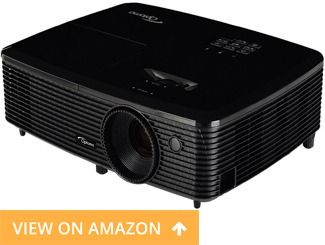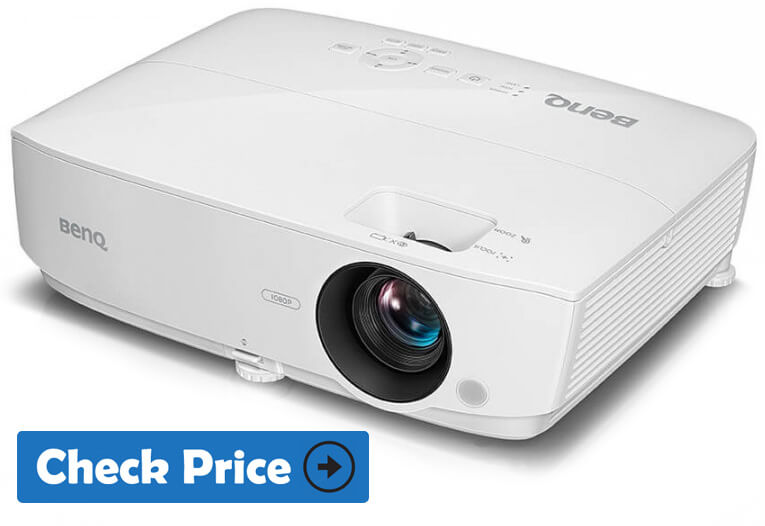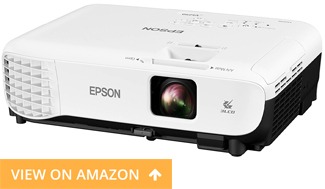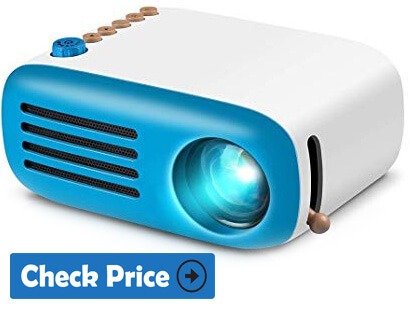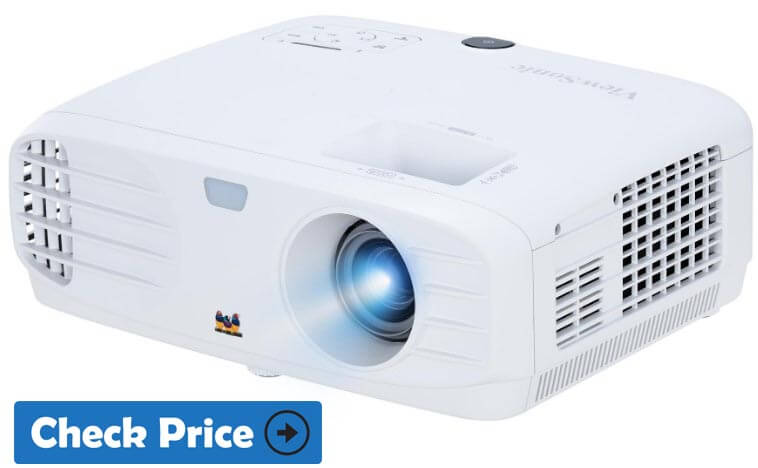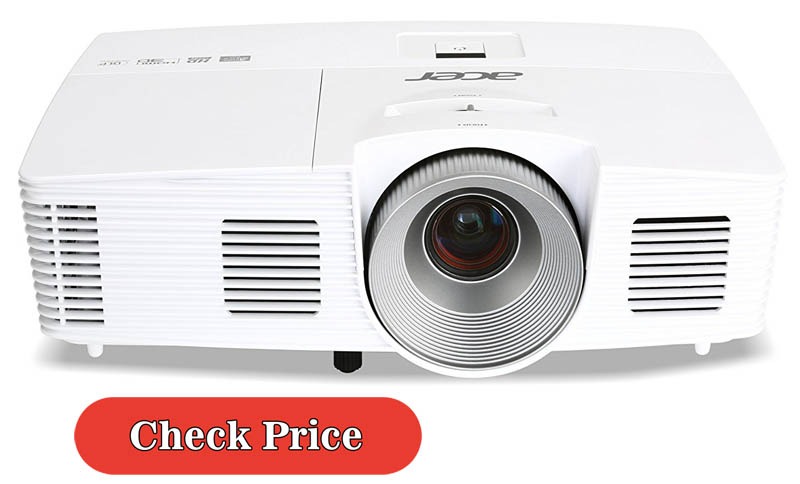Enjoying your favorite movies, TV shows or video games on a large screen can be an incredible experience, as you will perceive details that cannot be appreciated in smaller formats. In this sense, film projectors allow you to have a large screen and give you the possibility to take it with you to enjoy yourself with family and friends anywhere.
Therefore you have to buy the Home Theater Projector.
Today, I have reviewed a few best home theater projector that you can buy under 500 dollars.
What is the Best Home Theater Projector Under $500
Table of Contents
A Home Theater projector is the best option when it comes to large screens since you can project the image or video on any surface virtually anywhere, so you will be able to enjoy the home theater experience without major complications.
Starting from this point, we prepare the following guide to buy the best cinema projector, so that you can delight in the movies, sporting events, television series and even the video games that you like most from the comfort of your home.
Also Read: Best Projectors Under $300
Best Home Theater Projector Under $500 | Comparison Table 2025
Top Quality | 5-Stars Rating | Under $500
| Product Name | Type | Lumens | Resolution | Price $$ |
|---|---|---|---|---|
| Optoma HD143X (Editor's Choice) | DLP | 3000 | 1920 x 1080 | view on Amazon |
| BenQ MH535FHD | DLP | 3600 | 1920 x 1080 | view on Amazon |
| Epson VS355 | 3-LCD | 3300 | 1920 x 1080 | view on Amazon |
| GooDee Cheap Mini Projector | LED | 50 | 1920 x 1080 | view on Amazon |
| Epson VS250 | 3-LCD | 3200 | 800 x 600 | view on Amazon |
| ViewSonic Px700HD | DLP | 3500 | 1920 x 1080 | view on Amazon |
| Acer H5380BD | DLP | 3000 | 1900 x 1280 | view on Amazon |
Best Home Theater Projector Under $500 | 2025 Products Overview
1 Optoma HD143X DLP Home Theater Projector Under 500 (Editor’s Choice)
Key Specifications
- Type: DLP
- Brightness: 3000 ANSI Lumens
- Resolution: 1920 x 1080p Full HD WXGA
- Contrast: 23000:1
- Throw Distance: 1.47ft – 1.672ft
- Screen Size: 30-300 inches
- 3D Compatible
- Lamp Life: up to 12,000 Hours
About:
The Optoma HD142X has a very good overall image quality with Full HD resolution, solid contrast, and precise color. It is one of the cheapest projectors available for this level of quality.
This small black box filled the huge 300-inch screen of the test lab without any problem, presenting an image as detailed and accurate as any mid-range TV. Only much larger, and with an infinitely more impressive result.
Optoma states that it can obtain up to 8,000 hours using different lamp modes; The 5,000-hour figure is for the brightest (normal) mode. The HD142X has a lifespan similar to that of competitors and an average price for a replacement lamp. Epson projectors use cheaper lamps, while Viewsonic and BenQ are more expensive.
Image Quality
The biggest obvious improvement was the screen resolution: at 300 inches diagonally, the image can boast having all its 1080p pixels on the screen. The details were sharp, the edges were smooth and there was no visible pixel structure (screen door effect). The entire image seems much closer to what I am used to seeing, in detail, from a 1080p or 4K TV. You know, much bigger.
Also Read: Best 4k Projector Under 2000
With its 3000 lumens, the Optoma HD143X has a brightness quite honorable! Of course, the picture quality will be better in a dark room. But his abilities also allow him to get a good image in a room not totally dark. Unlike a TV, blacks will inevitably be less black depending on the brightness of the room. This projector offers a perfect brightness to watch your movies, but also for ppt in the meeting room.
The contrast ratio on this video-projector is 23000: 1 which is really good. Spotlights show better contrasts, but this is just an argument to sell more. Because with a bit of light, a white wall remains a white wall.
With a ratio of 1.47-1.62: 1 , the Optoma HD143X has a very good aperture. This is especially handy if you want to have a great picture but you do not have a huge setback to place the projector.
The service life of the lamp is around 12000 hours. Even if the Laser and LED technos have a longer life, it still leaves you a few years of use before having to replace it.
Connectivity
One of the last factors to leave aside is connectivity. It will determine if the HD143X is suitable for all of your devices. Let’s look at its interfaces more precisely.
HDMI : The HDMI interface is now a hardcore. It is a digital audio and video interface for transferring files in very high definition. Its advantage is certainly its ergonomics, easy to use.
- Darbee image processor technology
- Game mode
- 3D over HDMI
- Vert shift Of the objective
- 1.6x zoom
- Lens shift vert. only + 17%
- does not include analog AV (VGA) inputs
2. BenQ MH535 Home Theater Projector Under $500(Recommended)
Key Specifications
About:
If your thing is to watch movies without stopping, and you are worried about the lamp life, then this BenQ MW535 is your model. It is his great advantage over the rest, and that is why we have included him in this selection. You might well think that for that you buy a led projector. But the truth is that LED technology, for the same price, has not yet managed to match the traditional lamp in image quality.
Its resolution is somewhat lower. We talk about WXGA: 1,280 × 800. As for the contrast, it is also somewhat inferior: 15,000: 1. But its brightness is somewhat higher, 3,600 ANSI lumens. As for the sound, the safest thing is that we have to connect external speakers since it only has 2 watts. His shot is just over a meter and a half, and he also gets the 300-inch screen.
It presents a native resolution of 16:10, a little longer than the usual 16: 9, and for much better adapted to film content. But without a doubt, its strong point is the duration of the lamp, which extends its useful life up to 15,000 hours. That is why we have titled it as “ projector to watch movies ” because if your idea is to burn the device watching movies in the living room of your house, with this you guarantee more hours of entertainment.
Finally, this BenQ is also designed for office, since its brightness allows it. And so they have included a multi-screen function, where you can connect two devices at the same time and divide the image into two.
This projector is for you if ...
- You are concerned about the life of the lamp and want to extend it as much as possible without having to go to a led technology model.
- You plan to give it a shot watching many movies.
- If in addition to the home, you are interested in a versatile device and you may use it in other environments, such as the office.
- DLP projector ensures a bright, crisp image
- The speakers are already included
3. Epson VS355 Best Outdoor Projector
- Type: 3LCD
- Brightness: 3300 ANSI Lumens
- Resolution: 1280 X 800 WXGA
- Contrast: 15000:1
- Throw Distance: 1.49ft – 1.72ft
- Screen Size: 33-320 inches
About:
If you are looking for a versatile projector with many features at a reasonable price, look no further than Epson's VS355. The video looks fantastic thanks to the brightness above 3300 lumens, the contrast ratio 15000: 1 and the native WXGA resolution (1280 x 800), with dimensions up to 320 inches.
Equally at home in the meeting room or in the courtyard, a particularly dark environment is not necessary to use the VS355 - it is fine even in moderate sunlight or in a well-lit room. At 11.9 x 3.2 x 9.3 inches and 5.5 kilos, it is compact and light enough to move easily.
Image Quality
The resolution goes far beyond the classic pixels, reaching 1280 x 800, just enough to offer excellent multimedia experiences.
Operating costs are lower than average due to cheap replacement projector lamps that last up to 10,000 hours in Eco mode.
In order not to disturb watching movies or playing your favorite video games, the product is equipped with a cooling fan that reduces noise.
Lumens: The value is equal to 3,300, sufficiently high even for business uses that require presentations in illuminated offices.
Connectivity
With different input options, including USB, HDMI, VGA, and others, plus an optional Wi-Fi adapter, you have lots of choices when it comes to reproduction. As with many projectors, however, the built-in speaker is relatively weak: expect to place it in an external speaker to fill larger areas or noisy environments.
Also Read: Best Projector Under $1000 (Indoor & Outdoor)
- Vivid Color even in daylight
- Can use outdoor as well
- Keystone correction
4. GooDee Cheap Mini Projector
Key Specifications
- Type: LED
- Resolutions: Full HD (1920 x 1080)
- Display Size: 60 inches
- Brightness: 50 lumens
- Lamp life: 15,000 hours
- Contrast Ratio: 22,000:1
- Video inputs: VGA, HDMI
- Dimensions: 4.33 x 11.57 x 8.58 inches
- Weight: 0.59 Ibs
About:
Unlike previous styles, GooDee launched the small size of the projector for the first time!
It's a combination of art and humanity, so you can carry it with you wherever you want and play it the way you want! The GooDee Pico projector is easy to carry anywhere you put it in your bag.
It is ideal for use at home, camping, or small parties.
Features
The lamp life is extended to 30,000 hours, allowing it to last up to 20 years (4 hours per day).
The GooDee projector is suitable for research because it has less noise in use.
The projector uses ambient light made of ABS plastic and Bridgelux LED to protect the eyes and health.
For best performance, it is highly recommended that you use it in a dark environment.
This Mini projector is small and lightweight 0.59 pounds), and its unique design makes it easy to carry anywhere. Supports 5V / 2a portable charger power, both product and remote control Does not support including battery.
It creates a 20-inch image size and 0.8M ~ 2.0M projection distance. It provides a clear frame and projection size up to 60 inches.
The best gift for family and friends. For example, Thanksgiving / Christmas / Happy New Year
Just connect and play. GooDee Mini movie projector is easy to use. Powerful built-in speakers provide clear sound for movies, photos, games, and other everyday needs. Stimulates children's interests.
Connectivity
This compact projector is equipped with multiple easy-to-use ports such as HDMI, USB, micro SD card, audio and audiovisual interface.
It Supports Amazon Fire TV keys.
You can connect to a smartphone
Also Read: Best Pico Projector
- Portable design & Smart charging
- Rich & colorful interface
- Easy setup & Built-in Speaker
- None
5.Epson VS250 SVGA Projector
Key Specifications
About:
Epson VS250 is a portable projector sold for business presentations. More expensive than other projectors in this class and enjoyed some of the features such as automatic vertical keystone adjustment and excellent brightness level, but its low resolution output makes it difficult to read the projected text It becomes.
One of our favorite features is that the projector automatically adjusts the vertical keystone when extending the tripod. The support is a little unstable and made of plastic, but you can do the job.
Instead of the vertical keystone adjustment found on most other projectors, there is a horizontal keystone just behind the focusing dial. This is surprising because there is no need to point the projector directly at the projection surface.
You can make this projector more versatile by adjusting the keystone distortion with the projector turned sideways. For example, you can put it on a bedside table next to your bed and project a movie on the wall. The rear legs can also be adjusted, so you can level the projector on any surface. There is also a standard tripod mounting option.
Features
The lens is high quality and provides 3,200 lumens of brightness. We found that the focus adjustment was very smooth and accurate. Instead of the lens cover, the projector can be opened to expose the lens. Closing the cover turns off audio and video. We thought it was an exceptional design and the lens cap was not gone!
The fan and cooling system are very well designed, quiet and with a removable dust filter. The only 2W mono speaker is on the back of the projector, next to all connection ports.
Connectivity
The connection options are slightly different from the other projectors tested. There are HDMI and SVGA inputs, stereo audio, RCA video, USB-A, and USB-B ports.
All hardware buttons are at the top of the projector. Because it included remote control, only the power button and auto-detect button were actually used. The remote control includes software option shortcut buttons that are not included in the case hardware buttons.
The small 2W Epson monaural speaker is not very powerful and the sound is not so good, but it is a little better than the other projectors we tested. You can use the built-in speakers for business presentations, but it is recommended that you connect your laptop to a stereo system or portable Bluetooth speaker instead.
Also Read: Best Projector Under $500
- Automatic vertical keystone adjustment
- Very bright screen
- Robust build quality
- Silent fan
- Mono speakers are quiet
- Supplied with VGA cable only
- Transport bag is not included.
6. ViewSonic Px700HD Projector For Home Theater
Key Specifications
- Type: DLP
- Brightness: 3500 ANSI Lumens
- Resolution: 1920 x 1080p Full HD
- Screen Size: 300 Inches
- Contrast: 12000:1
- 3D Compatible
- Lamp Life: up to 15,000 Hours
About:
The ViewSonic PX700HD projector features 3,500 lumens ideal for home entertainment, full HD 1920x1080 native resolution, an intuitive and easy-to-use design, and an elegant white chassis. Proprietary SuperColor technology provides a wide range of colors to produce beautiful images in almost any environment.
Home entertainment and games
Ultra-low input latency speeds up action per frame and the sport mode feature provides amazing details so you can enjoy fast-action sports on a big screen. With full compatibility with HD 3D, you can enjoy 3D movies and games.
Flexible connection
Extensive connectivity options include dual HDMI inputs and USB power, making the PX700HD a versatile home entertainment solution.
Features
To experience a movie-like in cinema, you need cinema-like image quality. This full HD 1080p resolution projector delivers amazing detail, vibrant colors, and immersive images that you can take from home to the local Cineplex.
With a high contrast ratio of 3,500 lumens, this projector produces bright images in almost any environment.
Ideal for intense action-packed games, this projector delivers smooth images without delay. The ultra-low input latency of 16 ms speeds up action per frame.
Enjoy every sporting event on the big projector screen with special features in a sport mode that enhances details and colors to highlight everything from grassy fields to wooden floors, jersey colors and intermediate actions I can.
SuperColor Technology projects images with reliable color performance in both bright and dark environments without sacrificing image quality.
Connectivity
Wireless HDMI dongles (Google Chromecast, Roku Streaming Stick, Amazon Fire TV Stick, etc.) can be connected to the projector's HDMI port while supplying power with the USB cable connected to the USB A port. Since it is a dongle, no separate power supply is required.
Designed with two HDMI ports, this projector is ideal for connecting to HDMI-enabled devices and can display 3D images directly from a 3D Blu-ray player.
SuperEco energy-saving features reduce energy consumption and extend lamp life up to 15,000 hours.
Also Read: Best Gaming Projector
- Full HD 3D compatibility
- energy-saving SuperEco
- delivers smooth images without delay
- None
7. Acer H5380BD
Key Specifications
About:
The Acer H5380BD projector provides film-quality projection with rich details, bright and natural colors, and excellent contrast. Acer's eColor Boost II + technology and wall color correction improve the color performance of any surface, even on color walls. ColorSafeII is a projector, a practical installation utility that makes configuration easy, and an energy management solution creates great energy savings while conserving land resources.
Features
It has 720P native widescreen resolution that provides a true movie experience for the latest high-resolution content. The content reflects the original creation, and details are stored perfectly accurately, making it ideal for widescreen movies created in Blu-ray Disc and HDTV formats. Also, Its resolution at Maximum UXGA (1600 x 1200), WUXGA (1900 x 1280)
With 3D DLP support, users can view sequential content of 120 Hz 3D frames from a PC with an appropriate 120 Hz graphics card and a stereoscopic 3D player using 3D DLP glasses.
Easy to find with IR remote control, the Acer Empowering Technology key provides immediate access to all Acer projector technologies. ePower management, eView management, eTimer management, eOpening management.
Acer ColorBoost II + improves natural color temperature to achieve optimal color balance and uses Acer eView Management to improve color brightness according to content.
The instant resume feature allows the projector to resume projection immediately after it turns off. Users can turn the projector on and off at any time during the 2-minute shutdown process, so you don't have to worry about accidentally turning off the projector or waiting for a long cooling before resuming projection.
Eco Functionality & Protection
The world's leading ExtremeECO technology enables advances in lamp power control with the ability to dim the lamp to 30% of the total lamp power. If there is no signal input, the projector will automatically enter the ExtremeECO mode to save power. ExtremeECO can reduce projector power consumption by up to 70% and extend lamp life.
State-of-the-art dust shield solution technology is a cost-effective system for protecting the projector from dust and sand damage in the air. Acer projectors provide four protections: sealed motor, vertical plate, 3D dust filter, and lens protector to ensure the long-term performance of the projector.
Connectivity
The HDMI port is compatible with Mobile High-Definition Link (MHL) for easy connection to MHL compatible mobile devices.
- 3D over HDMI
- HDMI connection with MHL
- 3 watt speaker
- No 3D glasses included
How to Choose Best Home Theater Projector Under $500 | Ultimate Buyer’s Guide
DLP or LCD, WUXGA or Full HD, ANSI lumens, contrast ratio, lens shift - In the world of projectors it is necessary to update before choosing, in order to make the right decision. Taking as reference the latest technological advances of 2025, in this guide we have compiled for you the most important information about projectors.
Also Read: Outdoor Projector Buying Guide
Projectors for Home Theater or Lounge Cinema
We recommend a 16: 9 resolution projector for your home theater since most movies are available in this format. Full HD projectors (1920 x 1080 pixels) offer this resolution and have been established as a model for home theater. If you want to prepare for the future with the highest resolution, a 4K projector (3840 x 2160 pixels) would then be the right choice for you, as long as you generously plan your budget.
High-quality Full HD projectors for home theater also feature an image enhancement of up to 4K, such as 4K-Enhancement technology. This means that, by moving the 1080p panel, there is a significant improvement in resolution.
Nowadays a good projector for home theater has the 3D function, while a very good projector for home theater offers additionally another important feature: interpolation of frames in both 2D and 3D, which allows obtaining a smooth image with movements rapid.
Your home theater projector must have a contrast ratio of at least 10,000: 1 so that colors and curves can be displayed optimally.
The amount of lumens your projector needs depends on the brightness of the environment. If your home theater is completely dark, then a light output of approximately 1500 ANSI lumens will suffice. On the other hand, if there were a lot of ambient brightness at the installation site, then it would be necessary to have at least 3000 ANSI lumens.
To play high-quality Blu-ray movies, the projector requires an HDMI, HDCP or DVI port.
Volume is an especially important criterion for home cinema. If you want to enjoy movies in the tranquility of your home, the best option for you is a quieter projector of less than 30dB. In the room, however, the volume is less important, since factors such as light output play a more important role here.
The appropriate sound makes the home theater a perfect experience, but for this, it is not enough to use the internal speakers of the projector, so we recommend using an AV receiver with Dolby Digital or DTS decoder.
Brightness (Lumens) - How much light output should your projector present?
The brightness or luminous power of a projector is measured in ANSI lumens and indicates the amount of light that a projector can project over a given surface. To determine how much light output is necessary, the circumstances of the projection zone must be taken into account. Is the room dark? The brighter the ambient light, the brighter the projector should also be. Image dimensions and projection distance are equally important factors in determining the light power required by a projector because, at a greater distance, the light intensity is reduced.

The following are a couple of examples in relation to the light output required in different rooms. The figure shows the optimum brightness for LCD projectors. In the case of DLP projectors, approximately 1,000 lumens should be added to the values mentioned below, as long as color content prevails, because this technology slightly darkens the projected image.
How Many Lumens Do I Need For a Projector | Perfect Guide
Contrast - How are the lighting conditions in the workplace?
The contrast of min. 5,000: 1 for each projector
The contrast indicates the maximum difference in brightness between black and white. In a 1,000: 1 contrast ratio, the lightest point is, therefore, a thousand times lighter than the darkest point. The higher the contrast of a projector, the sharper and more natural the projected image will be.

The level of contrast always depends on the field of use and the brightness of the environment. High contrast is especially important in a home theater to produce an intense black color. In dark projection areas, high-contrast projectors can also reproduce vivid and realistic colors.
If you want to use your projector primarily in daylight or artificial lighting, the contrast will play a minor role in this case. However, each projector must have a contrast ratio of at least 5,000: 1.
4. Resolution / Format - How many pixels are needed for your projector?
The resolution indicates the number of pixels the image produces. The higher the pixel density, the sharper the image will be. The resolution required for your projector will depend on the purpose of use and the image source.
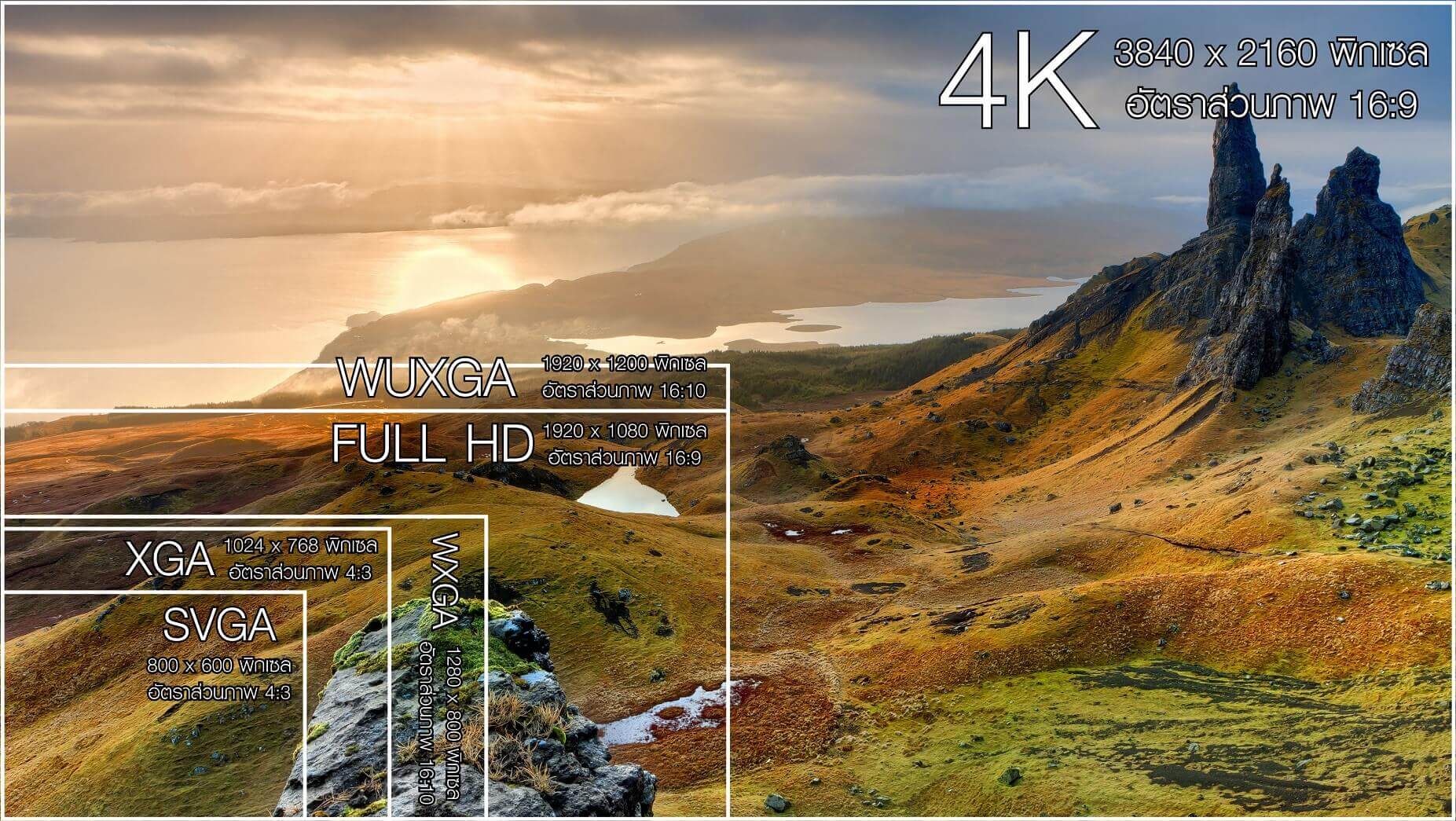
Because today we are used to high-resolution image quality thanks to TV sets and PC monitors, we advise you to start with a projector that has a minimum HD ready resolution. With an HD Ready projector (1280 x 720 pixels) you can watch DVDs on the big screen. If you want to obtain a very clear image of a Blu-ray, you should opt for a Full HD projector (1920 x 1080 pixels), which in turn is the best choice for PS4 or Xbox 360 players.
But the Full HD resolution does not Stay here - In a high section of home theater, there are already 4K projectors with a resolution of 3840 x 2160 pixels. Although there is not yet a large amount of content available in 4K quality, using a good amplifier (for example, an AV receiver) you can already enjoy Full HD content in 4K.
Also Read: Sony vpl-vw365es HRD Review | 4K Home Theater Projector
- SVGA = 800 x 600 pixels (4: 3 format) / Low range (today outdated by the low image quality)
- XGA = 1024 x 768 pixels (4: 3 format) / Low range and corporate scope (Currently it is only used to replace defective projectors)
- WXGA = 1280 x 800 pixels (16:10 format) / Corporate and multimedia scope
- HD ready = 1280 x 720 pixels (16: 9 format) / Low-end home theater
- Full HD = 1920 x 1080 pixels (16: 9 format) / Home theater / Corporate scope
- WUXGA = 1920 x 1200 pixels (16:10 format) / Corporate scope
- 4K = 3840 x 2160 pixels (16: 9 format) / High-end home theater
Volume - How many decibels are low and how many are high?
The noise value must be below 30dB
Depending on the field of use, the noise production of a projector will play a more or less important role. Both enjoy a movie in your home theater at night, and to avoid a high level of ambient noise during your presentation, your projector should not produce more than 30 dB.
Normally the larger your projector, the quieter it will be. For this reason, home theater projectors reach visibly faster values below 30 dB. A small portable projector is usually somewhat louder. The light output also plays a decisive factor: the brighter a projector is, the more noise it will produce. This is because the lamps, being more powerful, need to cool more. Next to the brightness, the fan frequency is also important if the noise production is annoying. Therefore, the dB value cannot always be compared directly.
Projector Technology - Which display system is the most suitable?
What techniques are there and how do they differ? We present the most important projector technologies and show you the pros and cons.
DLP: Especially suitable for the professional field and home cinema
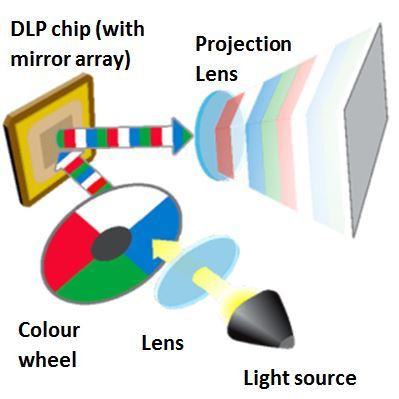 In the DLP (Digital Light Processing) system the image is made up of millions of tiny mirrors that project the light towards the screen. Each mirror corresponds to a point of light, whose tilting movement, invisible to the human eye, makes possible the production of a varied gradation of colors with a very good contrast ratio.
In the DLP (Digital Light Processing) system the image is made up of millions of tiny mirrors that project the light towards the screen. Each mirror corresponds to a point of light, whose tilting movement, invisible to the human eye, makes possible the production of a varied gradation of colors with a very good contrast ratio.
Thanks to the fine structure of mirrors, the visualization of the image are also very fine and no gridding is perceived in the image. DLP technology requires less space, so it is interesting for the production of smaller devices. DLP projectors work with a closed system from the light source to the target. As dust entry is not possible, DLP devices require little or no maintenance.
- Clear text and precise line drawing
- High contrast
- Durable DMD Chips
- Rainbow effect (slight colored flashes are perceived)
- Eventually, the color wheel is heard
- Lower color accuracy
LCD: Especially suitable for high-end home theater
 In the LCD system (Liquid Crystal Display) the white light of the projection lamp is divided into three primary colors: red, green and blue; and passes through three LCD screens. In this way, it is then assembled into a recognizable color image. To explain it more clearly, one could say that this system works like the operative ones, but instead of slides, it contains small liquid crystal elements that represent the image to be projected.
In the LCD system (Liquid Crystal Display) the white light of the projection lamp is divided into three primary colors: red, green and blue; and passes through three LCD screens. In this way, it is then assembled into a recognizable color image. To explain it more clearly, one could say that this system works like the operative ones, but instead of slides, it contains small liquid crystal elements that represent the image to be projected.
With LCD technology colors are particularly vivid, natural and with high quality; however, slight nuances in the saturation of the black level are distinguished. In contrast, in the home theater projectors, the black level is optimized.
- High image quality and color accuracy
- Precise pixel definition
- Something brighter compared to DLP technology
- In low-resolution conditions, the “wire effect” may occur
- Maintenance service (filter change required)
D-ILA, LCoS, and SXRD: Especially suitable for home theater
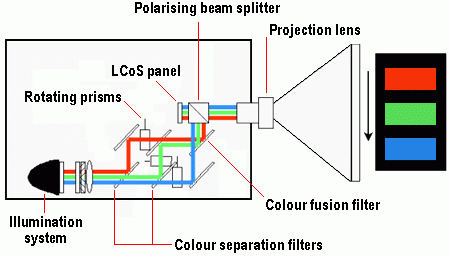 This system is known by manufacturers with different names: in JVC its name is D-ILA (Direct-Drive Image Light Amplification), Canon calls this technology LCoS (Liquid Crystal on Silicon) and Sony calls it SXRD (Silicon X-tal Reflective Display). However, all three have the same operation.
This system is known by manufacturers with different names: in JVC its name is D-ILA (Direct-Drive Image Light Amplification), Canon calls this technology LCoS (Liquid Crystal on Silicon) and Sony calls it SXRD (Silicon X-tal Reflective Display). However, all three have the same operation.
This system works much like LCD technology, but the panels reflect the light instead of letting it pass (as with DLP technology). Therefore, D-ILA / LCoS / SXRD brings together the advantages of DLP and LCD technologies.
- High resolutions
- No wire effect
- Better contrasts
- Less lumens
- Relatively high acquisition cost
Extras - What functions should your projector present?
Depending on the use, there are different extras that can simplify the use of the projector and have the following characteristics, generally very useful:
Optical zoom
- 2x zoom for more flexibility in home theater projectors
- Useful when an optimal distance to the viewing surface cannot be guaranteed
Lens shift
- Vertical and horizontal scrolling without image distortion, and without tilting the projector
- Useful when the projector cannot be placed in a central position, in front of the viewing surface
Keystone Correction
- Also: trapezoidal correction (to prevent trapezoidal deformations)
- The image is adjusted by means of the control keys on the upper end, in order to correct the deformation
- Useful for adjusting the image when the projector is tilted

Connections - Analog or digital ports?
As for the connection possibilities, it is important to think about which devices you want to connect to the projector. We generally differentiate between analog and digital ports.
Among the analog connections are the inputs for VGA, S-Video, composite video and component video, the VGA connection being the most used, if it is still necessary today.
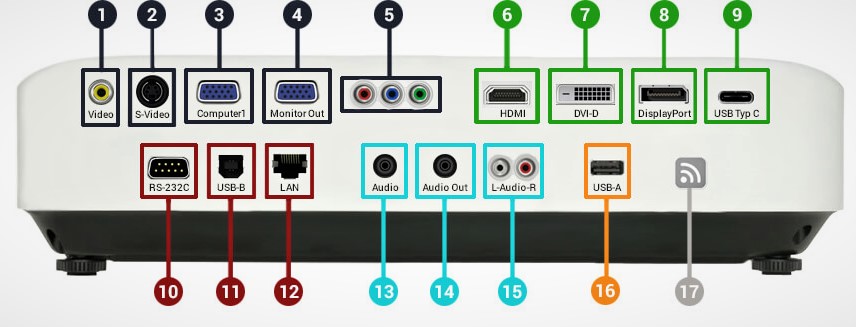
Digital connections, such as HDMI and DVI, are more common today because they offer better quality. It would be advisable to opt for one of these two connections in each purchase, in order to meet current requirements.
The main difference between these two types is that DVI is exclusively suitable for the transmission of images, while through HDMI the sound can also be transmitted. In general, the DVI connection is used today only for fixed installation projectors, because HDMI has been established for viewing high definition content.
If the source and projector have digital ports, we recommend that you always use a digital connection to ensure better image quality, for example, HDMI.
Installation - How is the projector placed correctly?
Distance to seats
The optimal distance between the viewer and the screen depends on the definition of the projector.
For an HD Ready resolution (1280 x 720 px) you must have at least 1.8x the screen width as the ideal distance to the seats.
If you want to use a Full HD projector (1920 x 1080 px), the minimum distance required for a quality image is 1.5x the width of the screen.
Do you still want to get a bigger picture? Then the ideal for you is a 4K resolution! With 4K projectors, you can reduce the distance to the seats up to 1x the width of the screen. Thanks to its high resolution, the image is displayed in high quality and the pixel structure is not appreciated, despite the short distance.
- HD Ready resolution: distance = screen width x 1.8
- Full HD resolution: distance = screen width x 1.5
- 4K resolution: distance = screen width x 1
Placement
In the case of LCD projectors, the projector must be located, as far as possible, parallel to the lower edge of the screen, or, if it is a ceiling mount, it must be hung parallel to the upper edge from the screen.
The DLP projectors use frequently - called 'offset', which means that the image starts being something bigger. In this case, the projector should be placed a little below the bottom edge of the screen, or it should hang a little above the top edge of the screen. With the help of the Keystone correction, it is possible to make small corrections in the image.
Operating expenses - How much do replacement lamps cost?
When buying a projector, pay attention to the possible expenses derived from replacement lamps, the price of which may vary depending on the lamp between approximately 35 and 350 dollars.
Generally, the durability of a lamp is between 2000 and 4000 hours. In the case of portable projectors, the durability of the lamps is considerably less because the shape of the housing is different, and its duration value ranges from approximately 1000 to 1500 hours.
If you use the projector every day and want maintenance costs to be as low as possible, you may be interested in an LED projector or a hybrid Laser-LED projector, which can operate up to 20,000 hours without changing the lamp. In addition to the costs of the lamps, the expenses derived from their replacement should be included, in case the change is not possible by itself.
FAQs
What is the best cinema projector in 2025?
When we look for a film projector that stands out in the market for its benefits, we decide to consider its most significant characteristics, in order to help you make the most accurate decision. In this sense, we try to analyze the most important criteria, such as brightness, contrast, size, and connections, as well as the utilities they offer, their advantages and disadvantages.
Conclusion
This was all about Best Home Theater Projector Under 500 Dollars. Have we managed to let you know a little more about the different options and the most important purchase criteria? If you now know what features your projector should present, try our Projector Buying Guide ! In this way, by filtering our varied range of products according to your requirements, you can find the ideal projector for your projections!
And you, are you already enjoying your home theater projector? We wait for you in the comments.
